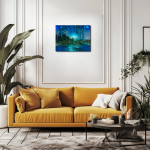Coastal Conduit: Monet’s Shore in the Age of Memory Vaults
Coastal Conduit: Monet’s Shore in the Age of Memory Vaults transforms Monet’s 1880s coastal landscape into a luminous vault of preservation and reverence. A grove of trees thrives beneath a vast glass dome, nourished by glowing circuitry and memory-rooted light. Sea and land exist in suspended harmony, offering a surreal meditation on nature remembered, landscapes preserved, and beauty sustained in a future shaped by care and consciousness.
Please see Below for Details…
Hotline Order:
Mon - Fri: 07AM - 06PM
404-872-4663
Claude Monet’s Coastal Landscape , painted in the early 1880s, is a luminous window into a world where sea, land, and atmosphere fold into one another with quiet ease. It is a painting rooted in rhythm—wind stirring through trees, light filtering over water, and the shoreline breathing against the horizon. In its original form, this landscape holds the tranquility of a coastal day, capturing the pulse of nature with delicacy and respect. In this digital collage reinterpretation, titled Coastal Conduit: Monet’s Shore in the Age of Memory Vaults , the familiar seascape is lifted into a futuristic vault—part sanctuary, part simulation—where memory and ecology are preserved in luminous circuitry and bio-intelligent structure.
What once was open and expansive is now contained. A vast glasslike dome encases the landscape, its structure formed from translucent blues and soft luminous threads. The sky has not been erased but reimagined. Instead of atmosphere, it is now filtered light—cast through hexagonal glass, digital gridlines, and atmospheric data spiraling overhead. The dome arches like a cathedral, filled not with stained glass but with ethereal patterns of motion and coded light. It is not a prison, but a preservation—a sanctuary designed to hold something that the outside world may no longer protect.
At the center of this space, Monet’s grove of coastal trees remains. Their trunks lean in quiet motion, their crowns lush, slightly wind-swept. They are grounded in green, untouched in color, yet their placement is subtly unnatural—too centered, too preserved. They grow not from soil alone, but from a floor of soft circuitry, where luminous roots descend into a glowing base, as if nourished by memory itself. These trees are not simply living—they are remembered. Each leaf flickers with the soft light of a preserved moment, each shadow cast by more than just sunlight—it is cast by time.
Beneath them, the ground glows faintly blue. Not cold, but intelligent. It breathes like water, rippling with signals. At the heart of the structure, a conduit rises—a sculptural root system, formed of silver and light, reaching downward into the unseen foundation of this place. It is both altar and server, both life-source and archive. It pulses, softly, carrying more than energy. It holds memory. It remembers not only the trees, but the wind, the birdsong, the smell of salt on the air.
The distant sea remains. Its horizon is barely visible through the misted shell of the dome, but it glows softly, invitingly. This ocean does not crash or churn—it reflects. It becomes part of the vault's memory, a slow echo of every tide that once touched this land. Beyond it, a light glimmers—not sun, but something constant, programmed perhaps, or spiritual. A reminder that time, too, has been softened here.
Color guides the emotional tone with precision. The blue dominates—not in coldness, but in quiet clarity. It is the blue of deep water, of dawn before light, of thought and reflection. The greens of the trees are natural, but more vivid than nature often allows. They suggest renewal, yes, but also suspension—life maintained at its perfect point. The deeper silvers and electric whites of the root-conduit system offer contrast, reminding the viewer that this is no untouched sanctuary. It is designed. It is protected. It is artificial, and yet deeply reverent.
As the artist, I approached this reinterpretation as a response to a future in which landscapes may need to be remembered as much as preserved. Monet’s shoreline, once painted en plein air with wind in his hair, now rests within a chamber of reverent memory. The trees, the sea, the light—they continue, not as they were, but as they are held in collective care. This vault is not about nostalgia. It is about continuation. It is about how we hold onto beauty, how we honor what might otherwise slip away.
This digital sanctuary speaks to the tension between nature and technology, preservation and experience. It asks what it means to protect something—not by shielding it from change, but by building a space where its spirit remains whole. The vault is both a shrine and a server. It offers not only the image of Monet’s coast but the feeling of it, encoded into glowing light and transparent air.
In Coastal Conduit , the landscape is no longer fleeting. It is remembered with precision, preserved with reverence, and transformed into a timeless realm where past, present, and possible futures converge. It is Monet’s world, dreamed forward—not erased, but reimagined through the lens of hope, memory, and the quiet brilliance of care.
Add your review
Your email address will not be published. Required fields are marked *
Please login to write review!
Looks like there are no reviews yet.








